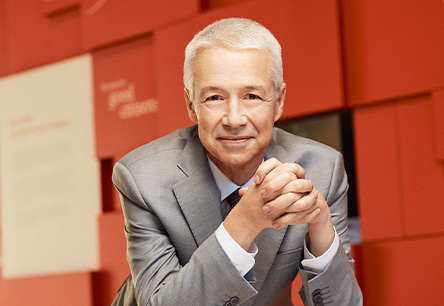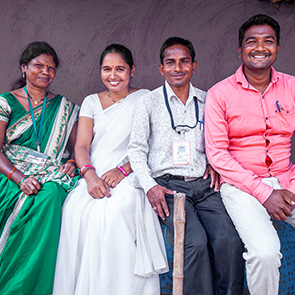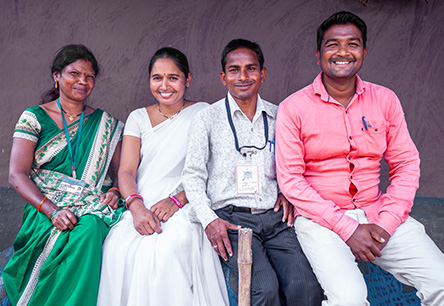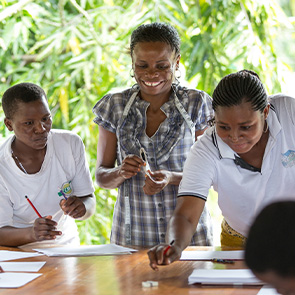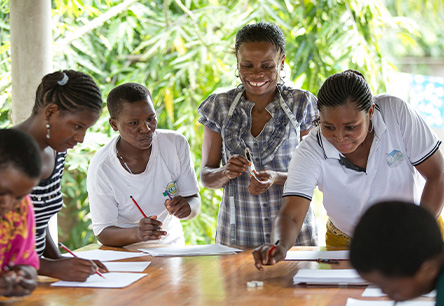Across Johnson & Johnson, we continue to build on our legacy of more than 135 years of blending innovation, scientific excellence and caring for people to tackle some of today’s toughest health challenges and help deliver improved health for all, everywhere.
At the core of our mission is a commitment to advance global health equity. For that to become a reality, people need to have access to affordable lifesaving and life-enhancing treatments in every corner of the world. This need is even more acute due to the COVID-19 pandemic, which has severely disrupted essential health services, shortened life expectancy and exacerbated inequities in access to basic health services.9
Two billion people worldwide are unable to access essential medicines and healthcare services.10
Access to medicine is central to our global health equity strategy and is embedded in our Health for Humanity 2025 Goals across several explicit commitments. Our progress against these commitments is described in this Report and summarized in our Health for Humanity 2025 Goals Scorecard.
More than 180 million patients treated globally with a Janssen medicine in 2022
Note: Patients treated represents the estimated number of people globally who were treated with a Janssen medicine in 2022, including patients reached through our VERMOX (mebendazole) donation program. This total excludes people vaccinated with our Johnson & Johnson COVID-19 vaccine, which is reported separately. We estimated the number of patients treated by converting quantities of Janssen medicines into courses of therapy or total patient days of therapy per year and then converting those into numbers of people based on average utilization per patient.
Patients taking multiple Janssen products may be counted as multiple patients in the total. Methodologies may vary by product type given the nature of the product and available data. Our estimated number of patients treated may be revised over time as we gain new information on patient usage or experience restatements in underlying data sources or changes in product portfolios.
In all that we do, we seek to enhance access to our innovative medicines, vaccines and medical technologies everywhere, especially for populations in resource-limited settings. We share our progress in making our medicines and technologies available to help combat specific diseases such as HIV, TB, Ebola and certain NTDs in the Pandemics & Epidemics section of this Report.
Taking a lead in access to medicine
Our progress in advancing access and innovating novel medicines was recognized by the Access to Medicine Foundation in its 2022 Access to Medicine Index (ATMI) in which Johnson & Johnson ranked second, rising from third in 2021.
Jennifer Taubert
Executive Vice President, Worldwide Chairman, Pharmaceuticals, Johnson & Johnson
Johnson & Johnson’s Current and Cumulative Accomplishments Recognized by the 2022 ATMI Include:
2nd largest R&D Priority Pipeline
with 64 projects addressing diseases such as HIV, TB and dengue and the 3rd largest overall R&D pipeline in scope for ATMI with 101 projects
2.2 billion doses
of our medicine VERMOX (mebendazole) to treat children infected with intestinal worms donated since 2006
10 initiatives
addressing health systems strengthening and R&D capacity building were noted as meeting all Good Practice Standards
100% of access plans in place
for eligible late-stage projects—40 projects in total
>586,000 courses
of our medicine SIRTURO (bedaquiline) to treat multidrug-resistant TB delivered since 2014
9 initiatives
addressing supply chain and manufacturing capacity building were noted as meeting all Good Practice Standards
3 Centers for Global Health Discovery
to support research to address critical health challenges, including TB, AMR and dengue
264,000 people
vaccinated with our Ebola vaccine regimen
$100 million
invested to help establish the $1 billion AMR Action Fund
Phase 1
clinical study completed that evaluated a dengue-specific antiviral treatment and prophylactic use
Digital Public Good designation
achieved for VXNAID, our vaccination monitoring platform
Making progress by design
We apply our Janssen Access and Pricing Principles across our entire pharmaceutical portfolio, planning for access early in the research phase. We work systematically for each asset in development to thoroughly understand the disease characteristics, patient burden of disease and product characteristics. In our access planning, we consider health system characteristics, access and affordability, applying a variety of approaches, including value-based pricing, equity-based tiered pricing and other access initiatives tailored to the disease and product, as we work with other stakeholders to enable patient access to medicines across a wide variety of health system characteristics and country ability and willingness to pay.
Janssen, along with our Global Public Health organization, deploys a lab-to-last-mile approach to fight diseases such as HIV, TB and Ebola, driving targeted innovation and initiatives to overcome barriers to deliver access to our medicines, strengthen health systems and support frontline health workers.
Johnson & Johnson products (addressing HIV and intestinal worms) are on the WHO List of Prequalified Medicinal Products.
Johnson & Johnson products (our Ebola vaccine regimen12) are on the WHO List of Prequalified Vaccines.
11 WHO, “Medicines/Finished Pharmaceutical Products,” https://extranet.who.int/pqweb/content/prequalified-lists/medicines.
12 A two-dose Ebola vaccine regimen comprising ZABDENO (Ad26.ZEBOV) and Bavarian Nordic’s MVABEA (MVA-BN-Filo).
Advancing access in the U.S.
Equitable access strategies are important not only in LMICs, but also in higher-income countries that are home to vulnerable and under-resourced populations as well. With a focus on access in the U.S., in 2023, we published our seventh annual Janssen U.S. Transparency Report, sharing updates relating to our pricing of medicines, our R&D investments and patient support programs. Notable details include:
- $33.9 billion paid in rebates, discounts and fees*
- (3.5%) average net price decline of Janssen medicines, declining for the sixth year in a row.*
As a signatory to the Business for Social Responsibility (BSR) Guiding Principles on Access to Healthcare, we engage broadly across our industry to improve access for patients around the world. In 2022, we collaborated as a member of BSR’s working group to develop the Access to Healthcare Ladder.
Access to treatment in the last mile
As part of Johnson & Johnson’s commitment to advancing equitable access to medicines, we funded an innovative pilot study by the Infectious Diseases Institute in Uganda to assess the impact of medical drones in increasing access and improving community disease management. The pilot study used a small, unmanned aircraft to deliver HIV treatments to the people of the Kalangala islands. As a result of this pilot project, researchers were able to quantify the effectiveness of medical drones’ HIV drug delivery, which will help inform future efforts to scale drone technology to solve other last mile delivery challenges in Uganda and elsewhere.
Supporting the patient advocacy community
Our 2022 HEALTHEVOICES leadership conference convened nearly 100 leading online patient advocates for three days of learning, sharing and debating on topics such as the impacts of culture on health, bridging change in the healthcare space and culturally inclusive marketing. This much-awaited event was the first in-person conference since before the COVID-19 pandemic and the eighth annual HEALTHEVOICES conference since its inception in 2015. HEALTHEVOICES is designed by and for online patient advocates, offering a safe space to deliver authentic content on the most pressing issues impacting patients. Approximately 50 Johnson & Johnson leaders attended the 2022 conference, demonstrating our keen commitment to understanding patient needs and empowering patient advocates to influence how we communicate with and to patients to improve patient experience.
The HEALTHEVOICES community reaches a vast digital network of more than 800 advocates across nearly 100 health conditions with a collective reach of 17 million patients, caregivers and healthcare professionals.
Advocating for inclusive access
The HEALTHEVOICES Diversity, Equity, Accessibility & Inclusion (DEAI) Task Force shapes health-equity-focused programming for patient advocates and Johnson & Johnson audiences, supported by close to 30,000 followers on social media. In 2022, HEALTHEVOICES, with the support of the DEAI Task Force, published an Instagram Live series on transgender health, advocacy and allyship; generated educational social media campaigns around 12 awareness events throughout the year, including Juneteenth, Pride and Hispanic Heritage Month; issued public statements in support of the AAPI and LGBTQIA+ communities following violence against them in the U.S.; and participated in discussions on health equity with Johnson & Johnson leaders. Ongoing DEAI Task Force activities such as these add vital momentum to driving equitable change in healthcare and sustaining trust between patient communities and Johnson & Johnson teams, resulting in a stronger patient voice across our broad range of healthcare interventions.
Howard Chang
Psoriasis Advocate & former HEALTHEVOICES Conference Advisor
9 United Nations, Department of Economic and Social Affairs, Sustainable Development, “Goal 3: Ensure healthy lives and promote well-being for all at all ages,” https://sdgs.un.org/goals/goal3, accessed February 2023.
10 Big Pharma, Access to Medicine Foundation, “R&D-based pharma companies,” https://accesstomedicinefoundation.org/sectors-and-research/big-pharma, accessed February 2023.
* Figures according to Janssen internal financial accounting.


